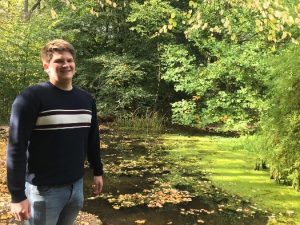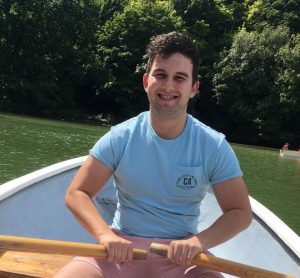Olusegun Ayodeji Adesina Leak noise characterisation for buried pipelines
Supervisor – Dr Jen Muggleton, Dynamics
Project Funder: CDT-SIS and The Petroleum Technology Development Fund in Nigeria
Project Details: Pipeline network system remains an essential infrastructure globally as it is the safest and most economical way of transporting water from the suppliers to the consumers. Sadly, enormous amount of water resource is lost in the UK every single day due to pipe leakages and these constitute huge economic losses, damages to the environment as well as to the health and wellbeing of humans, plants and animals.
My research will seek to contribute to the initiative proposed by UK water industry research
(UKWIR): ‘’achieving zero leakage in the year 2050’’. In achieving this aim, the following objectives have been identified:
➢ To characterise differences in leak signals between metal and plastic pipes.
➢ To determine how leak characteristics: shape, size and flow rate affect leak signals.
➢ To find out the effects of pipe dimensions and materials on the acoustic signatures.
➢ To deduce how different soil types and content pressure can influence leak signals.
➢ The effects of surrounding soil on buried pipelines
➢ To determine mechanisms of leak signals
I have already started working with Portsmouth water and the collaboration gave me an insight into how water leaks are detected and localised in the real world. I have also had the opportunity of going to the field with the leak detection team, I have collected real data and have analysed them. I would continue working with Portsmouth water to find solution to the challenges of leak detection and location on plastic pipes. I would acquire leak data from plastic pipes with pressure and acceleration sensors and compare results obtained, estimate time delay with GCC estimators and establish which is best for plastic pipes. In addition, I would compare and contrast leak spectra from plastic and metal pipes to determine their consistency with frequency power law. In the laboratory, I would build an experimental rig and compare findings with those obtained from real leaks in the UK WDS. |
 Will Crawford-Jones Fundamental Insights into Sediment Transport Will Crawford-Jones Fundamental Insights into Sediment Transport
Supervisor – Dr Sergio Maldonado-Villanueva, Water and Environmental Engineering
I studied Civil Engineering at The University of Exeter between 2010 and 2014, gaining an MEng in Civil Engineering. I then immediately went on to work for the engineering company MWH Global for 3 years before moving back to academia to work within SIS (Sustainable Infrastructure Systems) on my project titled Fundamental Insights into Sediment Transport, with supervision from Dr. Sergio Maldonado Villanueva and Dr. Gustavo de Almeida.
Project Funder: EPSRC
Project Details: Quantitative prediction of sediment erosion and accumulation rates is crucial for many applications in Civil and Environmental Engineering, including dam silting and bridge scouring, to name just a few.
However, when compared to the study of pure water flows (hydrodynamics), our knowledge of the interaction between fluids and sediment is very limited, and heavily relies on empirical methods. We thus propose to generate fundamental insights into the field of water-sediment flows in order to improve our predicting capabilities and engineering tools.
Our understanding of initiation of sediment motion in open channels is largely based on empirical studies carried out in the 1930’s by Shields. Shields concluded that sediment motion begins when a critical shear stress, τc, is reached. However, this approach has been criticised ever since, due to its well-known unreliability.
Recent research has shifted towards an approach where the problem is studied at the scale of sediment particles, with promising results.
The aims of this PhD project are to:
- Study the process of initiation of motion using a theoretical approach, that is, reducing our reliance on empirical coefficients as much as possible
- Use highly controllable experimentation to further back (or otherwise) conclusions made at a theoretical level
- Confirm the findings of more recent studies that suggest impulse (i.e. time integral of force) is a more accurate means of predicting sediment transport
Vary size, shape, packing arrangement and other relevant parameters to establish their effect on sediment particle entrainment. |
 Jack Daniels Investigating novel uses of electricity in freshwater ecosystems Jack Daniels Investigating novel uses of electricity in freshwater ecosystems
Supervisor – Prof Paul Kemp, Water and Environmental Engineering
I graduated from the University of Bristol with a BSc in Zoology in 2018. While completing my degree, I was involved in a variety of research projects ranging from camouflage to freshwater ecology, and also worked with several conservation organisations.
I joined CDT-SIS at the University of Southampton in September 2018, with the aim of improving techniques to mitigate the impacts of anthropogenic effects on freshwater ecosystems.
Project Funders: CDT-SIS & EPRI
Project details: River ecosystems are facing a variety of threats due to anthropogenic interference, and current research is focusing on engineering methods to mitigate these impacts. One of the most promising solutions is the use of electricity, which may help to reduce the impacts of river infrastructure on fish, and provide a method of controlling the movement of invasive species.
Recent work has suggested that electric barriers could be used to control the movements of fish at hydropower facilities, potentially providing a means of increasing habitat connectivity and fish survival. Future work will focus on quantifying the efficacy of these barriers, and enhancing their effectiveness by determining the impacts on different species.
A particularly interesting use of these barriers is the control of the movement of freshwater invasive species. Research in this area is currently very limited, but future work will focus on the possibility of species-specific barriers and integrating these barriers into effective management plans. |
 Lewis Dolman Exploring the relationship between river restoration and flood risk management Lewis Dolman Exploring the relationship between river restoration and flood risk management
Supervisor – Prof Paul Kemp, Water and Environmental Engineering
I graduated in 2017 from the University of Nottingham with an integrated MSci degree in Zoology. Here, I concentrated on ecology and animal behaviour within aquatic systems, particularly in the context of future changes caused by climate change and other anthropogenic impactors. For example, one of my projects investigated how future climatic changes will impact behavioural decisions within riverine invertebrates.
I joined the 4-year CDT-SIS programme at the University of Southampton in September 2018, during which I will continue investigating river ecology and human-caused impacts on these systems.
Project Funders: EPSRC and The Environmental Agency
Project details: UK river systems have been modified by humans for a multitude of reasons (e.g. flood risk mitigation, hydropower) for millennia. Widespread efforts to restore rivers to a more natural condition (e.g. by reinstating meanders, enhancing instream structural complexity and removing infrastructure) for the purpose of enhancing ecological condition also have the potential to reduce flooding risk.
Working in close collaboration with the Environment Agency, this project will use case study examples to explore the hydrogeomorphological and ecological responses of rivers to restoration projects. State of the art technology, including Acoustic Doppler Current Profiler (ADCP) to map bathymetry and velocity, will be employed to quantify the physical, chemical and ecological responses to restoration activity. Further, modelling approaches will be employed to assess flood risk pre- and post-restoration for different projects.
More specifically, it is anticipated that this project will investigate: (1) short-term (< 1 year) and long-term (> 5 years) responses of fish and invertebrate populations to restoration projects, (2) how restoration enhances the capability of rivers to hold /reduce the impacts of water during flood events, (3) how geomorphic complexity relates to the persistence of communities during flooding events. |
 Amelia Holgate Development of behavioural deterrents for power stations Amelia Holgate Development of behavioural deterrents for power stations
Supervisor – Prof Paul Kemp, Water and Environmental Engineering
Amelia Holgate graduated from University College London (2014-2017) with a BSc (Hons) degree in Chemistry. Following that, she graduated from University of Southampton (2017-2018) with MSc Environmental Science. Upon completing the MSc, Amelia followed her research interest in bioacoustics and began working towards an iPhD seeking to quantify the response of freshwater fishes to acoustic stimuli.
Project funders: EPSRC
Project Details: Populations of freshwater species have declined 83% since 1970 and efforts from the scientific community are essential in preventing further deterioration. Multiple approaches have been executed to reduce population decline at river infrastructure (e.g. inlet screens). Of particular interest are acoustic deterrents which have been implemented to reduce fish mortality at places of harm or to control the dispersal of invasive species. For acoustic deterrents to be effective there must be a comprehensive understanding of how fish behave in response to a stimuli and what stimulus characteristics will elicit a desirable reaction.
The requirement for a fully systematic approach in acoustic deterrent development should consider the frequency, signal to noise ratio and signal characteristics which will elicit a desired response based on the hearing abilities and behaviour of the target species. Therefore, it is essential to return to fundamentals in fish behaviour to understand what will constitute an effective acoustic deterrent. |
 Rahma Nassoro Hydrant Dynamics for Leak Detection Rahma Nassoro Hydrant Dynamics for Leak Detection
Supervisor – Dr Jen Muggleton, Dynamics
I graduated with a BSc in Chemistry in 2018 from the University of Southampton. Throughout my undergraduate degree I was interested in ways to conserve natural and renewable resources. I joined the leak detection project after graduating as its fundamental aim is to conserve water which is a very important resource in daily life.
Project Funders: UKWIR (UK Water Industry Research)
Project details: Leakage from pipes is a major issue in the water industry. The UK Water Industry Research (UKWIR) have recently set up the Zero Leakage 2050 initiative that aims to address ‘How will we achieve zero leakage in a sustainable way by 2050?’
Acoustic methods predominate in the available leak detection methods, but their effectiveness is restricted for plastic pipes due to the high attenuation of the acoustic signals. One of the reasons for this is that much of the acoustic signal can be lost when travelling from one pipe to the detection sensor that is usually located on the hydrant. Recent measurements suggest that a resonance of the pipe system at the points where the sensors are attached usually a hydrant, can have a profound effect on the bandwidth of the measured leak noise.
The aim of the project is to investigate hydrant dynamics, so that new guidelines can be given for sensor numbers, type, and positioning and hydrant design. The project entails:
· Theoretical modelling of vibrational wave propagation in hydrants
· Laboratory measurements on simplified hydrants
Laboratory and field measurements on real hydrants. |
 David Stanley 3D Mapping of Geometrically Complex Seafloor Infrastructures using Marine Vehicles David Stanley 3D Mapping of Geometrically Complex Seafloor Infrastructures using Marine Vehicles
Supervisor – Dr Blair Thornton, Fluid Structure Interactions
I graduated from the University of Southampton in 2018 with an MEng in Mechanical Engineering / Mechatronics, having previously worked as an undergraduate systems and test engineer for a company developing hybrid vehicle powertrain products.
Project Funders: Biocam and EPSRC
Project Details: Photographic seafloor surveys using unmanned robotic vehicles are now routine. Analysis of the reconstructions produced can be used to track infrastructure deformation through time and document the impact of human activity and disasters on marine ecology. But any artefacts and inconsistencies in the reconstructions can be hard to identify, potentially leading to misinformed decisions.
A current setup used is ‘structured light’. This combines lasers with cameras, where observations use sensor calibrations and are fed forward through models that estimate vehicle position, to create 3D scenes. However, even small uncertainties in the setup and sensor noise can lead to large visual and shape imperfections.
My project aims to improve the consistency of 3D reconstructions by feeding back the shape and visual features from multi-pose images and structured light, and to enable exploration (visualisation) and interrogation (measurements, semantic overlays) of multiple reconstructions. The novel approach will be to:
· Match together revisited features using particle filter SLAM (simultaneous location and mapping) for the structured light setup, updating considered position and constructed map.
· Quantify uncertainty in the lens and laser models to apply constrained bundle adjustment, using multiple sets of colour and laser data for the same features to adjust parameters for maximum consistency.
· Combine the two approaches for a complete closed loop approach to structured light seafloor mapping. |
 Christopher Tacon A porous micro-electrospray propulsion system for CubeSats Christopher Tacon A porous micro-electrospray propulsion system for CubeSats
Supervisor – Dr Stephen Gabriel, Electrical Power Engineering
I graduated with an MEng in Aeronautics and Astronautics / Spacecraft Engineering from the University of Southampton in 2018. Over the course of my degree I was involved in: the development of the University’s CubeSat (UoS3), the design and build of a 3D printed regeneratively cooled bipropellant rocket engine and investigating the stability of the space debris population.
I decided to continue my studies at the University of Southampton in the field of spacecraft propulsion. My project is titled “A porous micro-electrospray propulsion system for CubeSats” and the aim is to further the development of electrospray propulsion systems featuring porous glass emitters.
Project Funders: EPSRC
Project details: As interest in small satellites grow, the demand for small-scale propulsion systems also increase. Small satellites, such as CubeSats, benefit from the addition of propulsion systems as it allows them to perform tasks that would not otherwise be possible such as changing their orbits after launch or operating in low altitude orbits where there is higher atmospheric drag.
Electrospray propulsion systems offer a low cost, low mass and relatively simple solution to this increased demand. They generally exhibit high specific impulse and efficiency which enables them to have far reaching applications, with small satellites, from station keeping to interplanetary missions. They can also provide very small precise thrust, allowing for fine control in the case of formation flying or accurate drag compensation.
These thrusters operate by accelerating charged particles or ions, extracted from a liquid propellant held on the tips of very small cone shaped emitters, using an electrostatic field.
This project will investigate multiple aspects of the theory and design of porous electrospray propulsion systems. These are a type of electrospray thruster where the propellant is fed to the tips of the emitters through a porous material, rather than using a traditional capillary method. |
Ndubuisi Uchendu Combining Transient and Steady State Methods for Acoustic Leak Detection
Supervisor – Dr Jen Muggleton, Dynamics
Project Funders: UKWIR (UK Water Industry Research)
Project details: Acoustic leak detection methods are the most popular methods used for detecting and locating leaks in pipeline networks, notably in the water industry and the oil and gas sector. This is because of their low cost, ease of installation and deployment, simplicity of use, high accuracy and generality of use, as they can be used for detecting leaks on pipes of different materials and configurations. In these methods, leaks are located by analysing the vibroacoustic signals generated by the fluid as it escapes from the pipe through the leak opening. The leak signals consist of two parts – transient and steady state signals. Transient signals are the non-stationary and unstable signals generated at the moment of leak occurrence or pipe burst. They are usually short-lived. The steady state leak signals refer to the relatively stable signals that arise after the transient signals have subsided. Hence, transient leak signals correspond to the initial leak event, while the steady state signals correspond to ongoing leaks. By cross-correlating two vibroacoustic signals measured on either side of the leak, its position can be determined. However, despite the widespread use of acoustic leak detection methods, their effectiveness is limited by some challenges, which include high attenuation of vibroacoustic signals especially in plastic pipes, effects of high background noise, low sensitivity of sensors, inability to discriminate between multiple simultaneous leaks, effects of finite measurement time, etc. Most of these factors reduce the signal to-noise ratio of the measured signals, which in turn, reduces the accuracy of leak localisation. Currently, most research on acoustic leak detection focuses mainly on the analysis of steady state signals, as they are easy to acquire over any period of time using common sensors such as accelerometers, hydrophones and geophones. Furthermore, owing to extensive research in this area, there are well-developed methodologies for the analysis of these signals. On the other hand, there is a limited window of time for the acquisition of transient signals, as they are usually of short duration. In some cases, specialised sensors such as acoustic emissions sensors are required. Literature review shows that transient signals have been successfully used for structural monitoring and non-destructive testing in different fields. This suggests that transient acoustic signals may contain important information about leaks in pipe networks. The analysis of these signals can consequently provide an effective means for improving leak detection, especially in plastic pipe networks, where wave attenuation and background noise pose serious challenges. Likewise, transient leak signals can be potentially useful for real-time detection of leaks as they occur. Hence, the aim of this PhD project is to develop a novel approach with simultaneous analysis of transient and steady state leak signals for more reliable leak detection, while reducing the challenges outlined above. The research will be focused on the following broad objectives: • Study and analysis of the spectral energy of transient and steady state acoustic leak signals (timefrequency analysis). • Development and application of signal processing tools and possibly artificial intelligence methods for the characterisation and processing of acoustic leak signals. • Sensor configuration for effective simultaneous and real-time detection of transient and steady state leak signals. To achieve these objectives, in the early part of the research project, the following methodologies will be adopted (more will be added as the need arises and the project progresses): • Standard methods for steady state acoustic leak signal analysis (time delay estimation techniques, cross-correlation, short-time Fourier transform, etc.). • Transient time-frequency analysis using wavelet-based methods, Wigner-Ville distribution, and other advanced time-frequency representations. • Signal recognition analysis and onset detection (this is useful for leak noise characterisation). • Experimental techniques. • Theoretical modelling and simulation of transient and steady state signals (i.e. analysing the physics of leak occurrence and signal generation). |
 Keiran Ball Tribocorrosion of Marine Systems and Infrastructure Keiran Ball Tribocorrosion of Marine Systems and Infrastructure
Supervisor – Dr Ian Sinclair, Engineering Materials
Project Funders: EPSRC
Project details: Tribocorrosion is the interaction of a wear mechanism and corrosion on a metallic surface. There are various types of wear mechanisms, including adhesive, abrasive and erosive wear. I will be focusing more specifically on erosion and its interaction with corrosion in marine environments. There are many applications where this phenomena is relevant and impacts the service of different engineering systems, from that ship and submarine propellers, offshore oil rig platforms, underwater pipes and cables, as well as deep sea drilling equipment. There is a need to understand, mechanistically, the mechanisms of action of the process under various flow conditions. In marine conditions passive metals are used, meaning the metal forms a strongly adhesive, chemically inert layer in the scale of nano meters thick, which protect the metal from corrosion. However when this passive layer is disrupted by the impingement of a solid particle this can create an active site for chemical attack of the underlying metal. In most cases these redox reactions lead to repassivation of the protective layer, protecting the metal from attack. This process is both temporal and transient; a rough repassivation time for authentic stainless steels is given. However, under some conditions, this small area may grow and propagate until it causes pitting, which can detrimental to the engineering material and system. The problem is dramatically reduced service life and availability of plant or vessels which occurs due to an inability to predict the loss of material due to the combination of these material degradation mechanisms. Due to complex interplays in corrosive wear which are not fully understood, a 1mm3 /year corrosion and erosion rate will not lead to a 2mm3 /year tribocorrosion rate but can be many times larger. Clearly there is a necessity to understand the process and provide a model able to predict degradation of marine alloys, ranging from single phase austenitic SS to complex multiphase aluminium alloys. The aim of this project is to use novel experimental methods on a nanoscale to allow for an in-depth analysis of the interplay between mechanisms in tribocorrosion. By looking at the disruption to a passive oxide layer and measuring the repassivation kinetics of a single scratch/indentation/impact, factors such a crystal structure, phase, topography and orientation can be identified as having an effect on the corrosion of the material. By integrating a state of the art corrosion model and erosion model and comparing with nanoscale test results a more in depth understanding of the processes will be obtained and a more accurate predictive model produced. The experiments will inform next generation modelling approaches that mirror real tribocorrosion mechanisms at the microstructural scale of alloys and coatings By better understanding these interactions we can perhaps understand the synergy between them, defining a relationship between erosion enhanced corrosion and corrosion enhanced erosion; leading to more accurate models and allowing for better material selection for conditions where tribocorrosion is a problem, leading to tribocorrosion resistant structures, systems and coatings. |
Sam Reeve Development of an Electron Cyclotron Resonance Microwave Neutralizer for spacecraft electric propulsion
Supervisor – Prof Hugh Lewis, Astronautics |